The Shanghai-based Lnoppen and BMGI jointly conducted the second India Commercial Vehicle Summit 2013 in Pune on April 4 and 5. The event attracted thought leaders from the commercial vehicle industry from across the world with senior management representatives from OEMs, and Tier 1 & Tier 2 suppliers, including Ashok Leyland, JAC Motors, Daimler India Commercial Vehicles, John Deere, Volvo-Eicher Commercial Vehicles and Volkswagen.
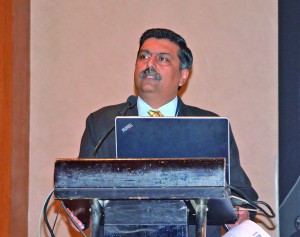
The event was kicked off by its chairman, Mr. Naresh Raisinghani, CEO & Executive Director, BMGI, who outlined the “India Story” for the commercial vehicle industry. He outlined the key challenges facing the industry, including management of customer preferences and input costs, besides the total cost of ownership and the strict environmental norms.
Mr. Raisinghani identified two key enablers that can be leveraged: the latent need and the support available. Given India’s vehicle density on the lower side, coupled with the planned spending on infrastructure (40 per cent on ports and roads till 2020), he asked if the current gloomy picture is just a blip.
Mr. Jeevanrao Gore, Chairman of MSRTC, stressed the importance of public transport. He touched on the benefits offered by public transport, including reduction in emissions and fuel consumption. While MSRTC provides 3,000 buses every year, they are only replacement of the scrap buses and increasing demand is not really catered to. MSRTC needed all-round to help meet its objectives.
Substantiating the event chairman’s India Story, Mr. Amit Kaushik, Principal Analyst, Truck Forecasting/Advisory, IHS Automotive, presented the trends and growth drivers for the industry. While global markets are affected by high unemployment rates and the euro crisis, the GDP growth and business confidence indicators seem to favour India. This further seems to be validated by the shifting of the global output towards emerging markets like India.
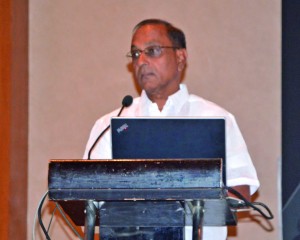
Mr. Kaushik also said that if the motivation for purchase today is price and brand of the commercial vehicle, it would be the total cost of ownership & service offered by 2020.
Supporting the India Story, Mr. Sudhir Mehta, Director, Force Motors, in his address on “Behaviour of Different Competitive Forces Driving the CV Industry, During The Next 5 Years”, said the centre of action will shift to rural emerging markets. With schemes like NREGA, the rural market has witnessed growing income causing higher consumption. This higher demand for goods leads to higher transportation requirements.
With LCVs forming about two-thirds of the market share in Indian CVs, he believed that the rural Indian story remains solid. He also alerted the industry to be watchful of the issues like increased fuel prices, taxation policies, labor unrest and, most importantly, the seemingly slower GDP growth.
The drivers and restraints for the India Story were re-emphasized by Mr. Nitin Seth, Executive Director, LCV, Ashok Leyland, as he shared his thoughts on the “Future of CV Industry”. He believed that while restraints like political instability and mounting inflation could pose a threat to the Indian CV scenario, the increasing disposable income and higher spending by the Government on infrastructure development provide much relief. The entry of global OEMs and Indians’ preference to road over rail as the mode of freight goods reaffirms the promise, he added.
Corroborating the shifts in market, viz., increasing LCV and declining M&HCV, he said that the goods LCVs are predicted to grow at a CAGR of 16.9 per cent while M&HCVs are pegged at 7.24 per cent. Further, improved road infrastructure and increased average running speed on highways have made it a profitable solution for providers to opt for HCVs in the place of MCVs.
He also said that India would eventually move to optimum-cost truck market from the current low-cost market. With a comprehensive SWOT and positive indicators, tailor-made products are required instead of a product intended for developed markets.
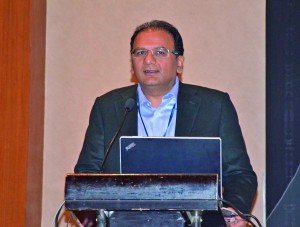
Mr. Vivek Kumar, Associate Director of CRISIL, identified availability of credit as one of the key enablers for CV sales.
Mr. Ramashankar Pandey, Managing Director of Hella Lighting, focused on the flipside of the India Growth Story as he recollected the statistics of road accidents which are currently one every minute, resulting in one death every four minutes. He criticized the general tendency to assign the fault to the driver, and urged the public to take a more responsible stance by shifting the focus on use of technology by the automotive aftermarket companies.
Substantiating the need for imbibing true world class practices, Mr. Christian Kellner, Head – Truck Operating System, India, Daimler India Commercial Vehicles, showcased Daimler’s Truck Operating System (TOS) and the importance of standardizing operations in the shop-floor through Daimler’s journey in adopting best practices across geographies. He also elaborated the procedure through which Daimler benchmarked some of the practices involving the people on the shop-floor, which also meant demonstrating through mocks the processes and practices that have not yet been transitioned into India.
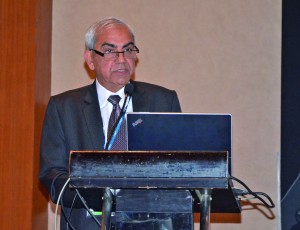
Speaking about the entry of global OEMs to India, Ms. Jina Kang of JAC Motors, with presence in over 100 countries that has demonstrated a rapid growth in sales for 21 years, shared JAC’s plans to enter India. With a unique management system that looks at technology innovation, management innovation, system innovation and marketing innovation, it is not surprising that JAC introduced the first bus chassis of the nation and has since been the biggest chassis manufacturer.
What is the impact of a low weight CV and sub-assembly level improvements on emissions? This was explained by Mr. Nandkumar Khandare, CEO, Nissan – Ashok Leyland Technologies. He identified the forces acting against the prime mover – resistance to acceleration, rolling and gradient, besides aerodynamics. Reduction in vehicular weight not only saves metal and its processing energy, but helps to stop the vehicle quickly. Besides, the Indian driving context requires a significant part of the energy in managing the tyres and the driver behaviour. If these can be handled along with improved combustion efficiency and electrification of accessories, the emissions challenge will also be met, besides improving the vehicle efficiency.
Sree Harsha from Dassault Systems, addressed issues from designs through technology to manufacturing. He began with the challenges CV manufacturers face – new ownership experience as well as new geographical focus; local market driven business; and managing the aftermarket. Solutions to enable global truck development included providing a customized, suitable and intuitive customer experience, in addition to being lean, green and compliant.
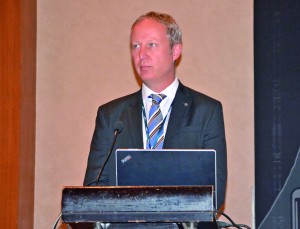
Mr. Praveen Kumar, CEO of RMP Bearings, showcased the company’s abilities in design and innovation in its products, which is evident from the fact that it is the first company to manufacture sheet metal yokes. He emphasized the need for innovation not just at the OEM level, but also at the sub-system level.
Echoing the thought of indigenous development capabilities to enhance the effectiveness of commercial vehicles, Mr. Sadashiv Pandit, Executive Chairman, Fleetguard Filters Pvt. Ltd., mapped the aggressive growth plans banking on their design capabilities.
With the transport sector heavily dependent on oil, is today’s transport mechanism sustainable? The double-bind we find ourselves with today: how to replace the oil consumed and how to reduce the CO2 emitted, seemed to find an answer through Mr. Krister Thulin, Director, Business & Coach, Scania Commercial Vehicles India, who made a case for Biogas & Bioethanol powered vehicles. He reminded the participants that it is a city dominated world with the cities are only expected to grow to mega-cities while higher deaths in the world caused due to air pollution. The director of the 122 year old company emphasized to clean up the cities by using vehicles that are powered by biogas – generated by using waste from cities and bio-ethanol.